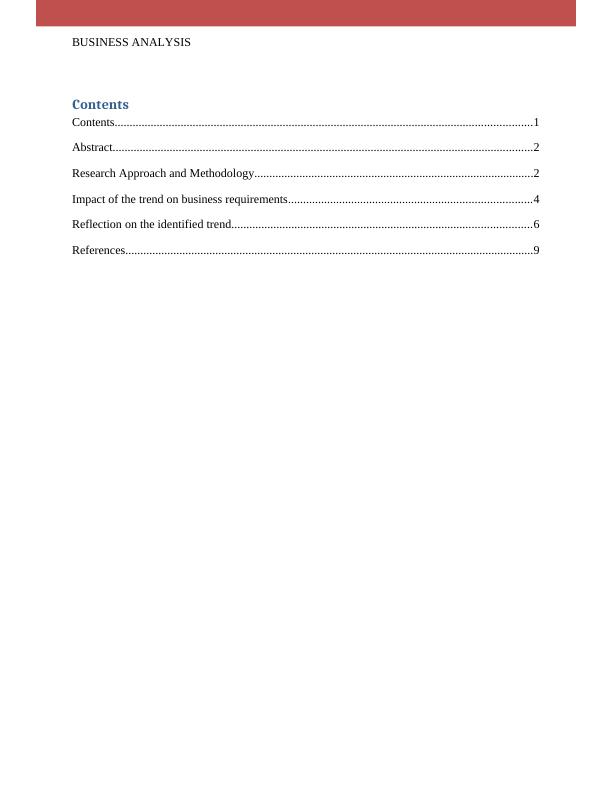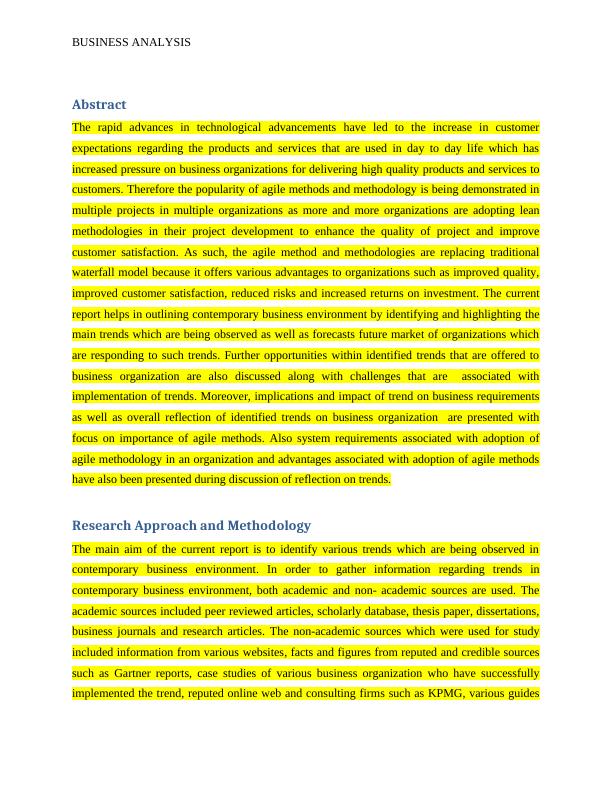Business Analysis
Added on 2023-04-06
12 Pages2988 Words254 Views
Business Analysis
name of student:
name of college:
authors note:
Running head: BUSINESS ANALYSIS
name of student:
name of college:
authors note:
Running head: BUSINESS ANALYSIS

BUSINESS ANALYSIS
Contents
Contents...........................................................................................................................................1
Abstract............................................................................................................................................2
Research Approach and Methodology.............................................................................................2
Impact of the trend on business requirements.................................................................................4
Reflection on the identified trend....................................................................................................6
References........................................................................................................................................9
Contents
Contents...........................................................................................................................................1
Abstract............................................................................................................................................2
Research Approach and Methodology.............................................................................................2
Impact of the trend on business requirements.................................................................................4
Reflection on the identified trend....................................................................................................6
References........................................................................................................................................9

BUSINESS ANALYSIS
Abstract
The rapid advances in technological advancements have led to the increase in customer
expectations regarding the products and services that are used in day to day life which has
increased pressure on business organizations for delivering high quality products and services to
customers. Therefore the popularity of agile methods and methodology is being demonstrated in
multiple projects in multiple organizations as more and more organizations are adopting lean
methodologies in their project development to enhance the quality of project and improve
customer satisfaction. As such, the agile method and methodologies are replacing traditional
waterfall model because it offers various advantages to organizations such as improved quality,
improved customer satisfaction, reduced risks and increased returns on investment. The current
report helps in outlining contemporary business environment by identifying and highlighting the
main trends which are being observed as well as forecasts future market of organizations which
are responding to such trends. Further opportunities within identified trends that are offered to
business organization are also discussed along with challenges that are associated with
implementation of trends. Moreover, implications and impact of trend on business requirements
as well as overall reflection of identified trends on business organization are presented with
focus on importance of agile methods. Also system requirements associated with adoption of
agile methodology in an organization and advantages associated with adoption of agile methods
have also been presented during discussion of reflection on trends.
Research Approach and Methodology
The main aim of the current report is to identify various trends which are being observed in
contemporary business environment. In order to gather information regarding trends in
contemporary business environment, both academic and non- academic sources are used. The
academic sources included peer reviewed articles, scholarly database, thesis paper, dissertations,
business journals and research articles. The non-academic sources which were used for study
included information from various websites, facts and figures from reputed and credible sources
such as Gartner reports, case studies of various business organization who have successfully
implemented the trend, reputed online web and consulting firms such as KPMG, various guides
Abstract
The rapid advances in technological advancements have led to the increase in customer
expectations regarding the products and services that are used in day to day life which has
increased pressure on business organizations for delivering high quality products and services to
customers. Therefore the popularity of agile methods and methodology is being demonstrated in
multiple projects in multiple organizations as more and more organizations are adopting lean
methodologies in their project development to enhance the quality of project and improve
customer satisfaction. As such, the agile method and methodologies are replacing traditional
waterfall model because it offers various advantages to organizations such as improved quality,
improved customer satisfaction, reduced risks and increased returns on investment. The current
report helps in outlining contemporary business environment by identifying and highlighting the
main trends which are being observed as well as forecasts future market of organizations which
are responding to such trends. Further opportunities within identified trends that are offered to
business organization are also discussed along with challenges that are associated with
implementation of trends. Moreover, implications and impact of trend on business requirements
as well as overall reflection of identified trends on business organization are presented with
focus on importance of agile methods. Also system requirements associated with adoption of
agile methodology in an organization and advantages associated with adoption of agile methods
have also been presented during discussion of reflection on trends.
Research Approach and Methodology
The main aim of the current report is to identify various trends which are being observed in
contemporary business environment. In order to gather information regarding trends in
contemporary business environment, both academic and non- academic sources are used. The
academic sources included peer reviewed articles, scholarly database, thesis paper, dissertations,
business journals and research articles. The non-academic sources which were used for study
included information from various websites, facts and figures from reputed and credible sources
such as Gartner reports, case studies of various business organization who have successfully
implemented the trend, reputed online web and consulting firms such as KPMG, various guides

BUSINESS ANALYSIS
such as BABOK guide and other sources such as articles published by Harvard Business review.
In order to identify and analyze various trends which are being observed in contemporary
business environment literature review was conducted and accordingly information was gathered
and integrated into a single report.
Detailed description of the significant trend identified
As opined by Amritesh and Misra (2014) agile methodologies are defined as a group of software
development practice which are established on iterative and incremental development. There are
four basic attributes which are common to all agile methodologies and these are adaptive
planning, iterative and evolutionary development, change and promotion of communication and
flexible reactions to change. As opined by Lappi and Aaltonen (2017) agile software
development is of the view that in a project, the production teams should begin with basic and
anticipated approximation of the closing requirement and then carry forward to increase the
details of those requirements throughout the life cycle of project development process. As opined
by Kisielnicki and Misiak (2017) the incremental requirements refinement further refines the
design, coding and testing during entire stages of production activities and therefore in this
manner the requirements of work products remains similarly exact and effective to the ultimate
software.
As stated by Brad, Birloi, Bratulescu and Blaga (2016) agile methods are defined as methods
which are iterative and incremental methods of management. These methods help the teams to
accommodate needs of ever-changing competitive landscape and also help business
organizations deliver business values effectively. There are various methodologies which are
used in Agile project management such as Scrum, XP, Kambanetc which also complies to the
manifesto of agile and are based on continuous improvement, flexibility, input of teams and high
quality delivery of results. The methodologies which are followed in Agile method help in
effectively addressing the needs of the customers of a company. Also, during the entire agile
cycle, the involvement of users are encouraged which helps in providing transparency and
visibility regarding all projects of a company. This in turn helps in providing knowledge
regarding the actual progress of projects. The agile method comprises everything about iterative
planning which makes it very easy to be adapted during the change of various requirements.
Moreover, due to the presence of continuous planning and feedback mechanism in the agile
such as BABOK guide and other sources such as articles published by Harvard Business review.
In order to identify and analyze various trends which are being observed in contemporary
business environment literature review was conducted and accordingly information was gathered
and integrated into a single report.
Detailed description of the significant trend identified
As opined by Amritesh and Misra (2014) agile methodologies are defined as a group of software
development practice which are established on iterative and incremental development. There are
four basic attributes which are common to all agile methodologies and these are adaptive
planning, iterative and evolutionary development, change and promotion of communication and
flexible reactions to change. As opined by Lappi and Aaltonen (2017) agile software
development is of the view that in a project, the production teams should begin with basic and
anticipated approximation of the closing requirement and then carry forward to increase the
details of those requirements throughout the life cycle of project development process. As opined
by Kisielnicki and Misiak (2017) the incremental requirements refinement further refines the
design, coding and testing during entire stages of production activities and therefore in this
manner the requirements of work products remains similarly exact and effective to the ultimate
software.
As stated by Brad, Birloi, Bratulescu and Blaga (2016) agile methods are defined as methods
which are iterative and incremental methods of management. These methods help the teams to
accommodate needs of ever-changing competitive landscape and also help business
organizations deliver business values effectively. There are various methodologies which are
used in Agile project management such as Scrum, XP, Kambanetc which also complies to the
manifesto of agile and are based on continuous improvement, flexibility, input of teams and high
quality delivery of results. The methodologies which are followed in Agile method help in
effectively addressing the needs of the customers of a company. Also, during the entire agile
cycle, the involvement of users are encouraged which helps in providing transparency and
visibility regarding all projects of a company. This in turn helps in providing knowledge
regarding the actual progress of projects. The agile method comprises everything about iterative
planning which makes it very easy to be adapted during the change of various requirements.
Moreover, due to the presence of continuous planning and feedback mechanism in the agile

End of preview
Want to access all the pages? Upload your documents or become a member.
Related Documents
Agile PM vs Waterfall PM: A Comparative Studylg...
|15
|712
|448
Incorporation of Data Analytics Assesmentlg...
|14
|4059
|29
Software Development Methodologies: Alternatives for Jharna Software Development Firmlg...
|5
|823
|279
System Analysis and Design | Reportlg...
|11
|1826
|72
Agile Project Management: Scrum Methodology for Construction Projectslg...
|15
|4533
|345
Factors Influencing Sales of Retail Organizationslg...
|10
|2268
|425
